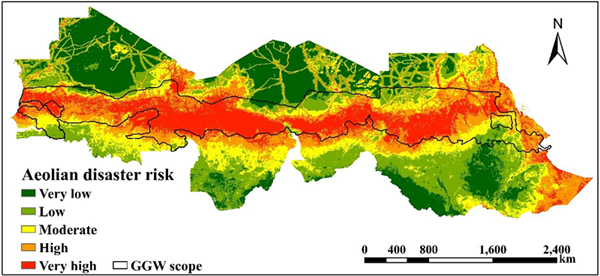Study Reveals the Spatiotemporal Change of Aeolian Disaster Risk in the Sahel, Africa
2023-08-04
The Sahel is facing a serious environmental crisis due to aeolian disaster that has seriously affected the local development and survival of residents. Thus, evaluating the aeolian disaster risk levels and their variation in the Sahel is important.
A research team from the Xinjiang Institute of Ecology and Geography of the Chinese Academy of Sciences has established an optimal model by evaluating the applicability of different models in the aeolian disaster risk determination in the Sahel.
Using this model, the spatiotemporal changes in the risk subsystem of aeolian disaster (hazard, sensitivity, vulnerability, and restorability) and the aeolian disaster risk in the Sahel from 2000 to 2020 were analyzed. Based on this analysis, the impact of climate change and human activities on the aeolian disaster risk in the Sahel was evaluated.
The study was published in Science of The Total Environment on July 13.
The researchers found that the variable fuzzy recognition (VFR) based on the aeolian disaster risk index (ADRI) model was the most suitable for the aeolian disaster risk evaluation in the Sahel, with an accuracy of 89.72%.
Through the analysis of the risk evaluation results of aeolian disaster in the Sahel from 2000 to 2020, it was found that the middle of the Sahel, located in the desert-grassland transition zone, exhibited a high hazard, sensitivity, and vulnerability, rendering it highly susceptible to aeolian disaster. Meanwhile, the very high-risk areas of aeolian disaster in the Sahel were highly consistent with the ones considered under the scope of the Great Green Wall (GGW) program. Countries in the Sahel should strive to promote the GGW program and reduce aeolian disaster risk in the region.
From 2000 to 2020, the areas where the aeolian disaster risk increased significantly are mainly distributed in the desert areas with few human activities, while the decreased risk areas are mainly in the central and southern areas where human activities are frequent. Therefore, relative to the overall human society, the aeolian disaster risk in the Sahel is on a downward trend.
Through intensity analysis and residual analysis, the researchers found that areas with low, moderate, and high aeolian disaster risk are more sensitive to climate change and human activities, and mutual transformation is frequent. Human activities played a key role in the ADRI change in the Sahel, accounting for 69.74% of the ADRI increase area and 58.19% of the ADRI decrease area.
The prevention and control strategy for aeolian disaster in the Sahel should focus on preventing infrastructure such as roads and oil fields in the hinterland of the desert from being buried by shifting sand, and moderate reclamation and grazing should be conducted on land in moderate-risk areas. At high and very high risk, countries in the Sahel should accelerate the implementation of the GGW program to form a green bulwark and fight desertification, wind erosion, and dust storms.

Fig. 1. Location of the 11 countries in the Sahel. The data on populated places comes from Natural Earth website (https://www.naturalearthdata.com)

Fig. 2. Spatial distribution of aeolian disaster risk and GGW program in the Sahel.
Contact:
LIU Jie
Xinjiang Institute of Ecology and Geography
Tel: 86-0991-7885505
E-mail: liujie@ms.xjb.ac.cn
Web: http://english.egi.cas.cn/



